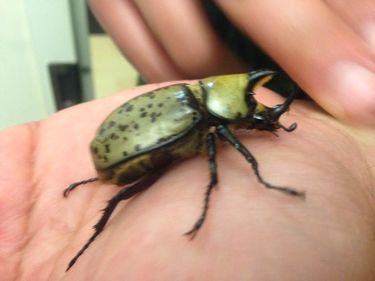Eastern Hercules Beetle: Difference between revisions
Jump to navigation
Jump to search
Chivon Morse (talk | contribs) No edit summary |
No edit summary |
||
| (4 intermediate revisions by 2 users not shown) | |||
| Line 1: | Line 1: | ||
[[Image: Hercules Beetle.jpg|right|thumb|375px|Hercules Beetle]] | [[Image: Hercules Beetle.jpg|right|thumb|375px|Hercules Beetle]] | ||
'''Eastern Hercules Beetle''' | '''Eastern Hercules Beetle''' ''Dynastes tityus'' | ||
A member of the rhinocerous beetle family, Eastern Hercules beetles are the largest beetle in the United States. The males are easily identifiable by a pair of horns sticking out of their heads, used to fight other males over territory. Larvae, in the form of large white grubs often seen under rotting logs, may take up to three years to become adults. | A member of the rhinocerous beetle family, Eastern Hercules beetles are the largest beetle in the United States. The males are easily identifiable by a pair of horns sticking out of their heads, used to fight other males over territory. Larvae, in the form of large white grubs often seen under rotting logs, may take up to three years to become adults. | ||
==References== | ==References== | ||
* Barnes, Jeffrey K.( | * Barnes, Jeffrey K. (July 20, 2003) "[http://www.fcps.edu/islandcreekes/ecology/eastern_hercules_beetle.htm Eastern Hercules Beetle]". University of Arkansas Department of Agriculture - accessed July 1, 2015 | ||
[[Category: Beetles]] | |||
[[Category: Native insects]] | |||
Latest revision as of 09:18, 18 January 2024
Eastern Hercules Beetle Dynastes tityus
A member of the rhinocerous beetle family, Eastern Hercules beetles are the largest beetle in the United States. The males are easily identifiable by a pair of horns sticking out of their heads, used to fight other males over territory. Larvae, in the form of large white grubs often seen under rotting logs, may take up to three years to become adults.
References
- Barnes, Jeffrey K. (July 20, 2003) "Eastern Hercules Beetle". University of Arkansas Department of Agriculture - accessed July 1, 2015
